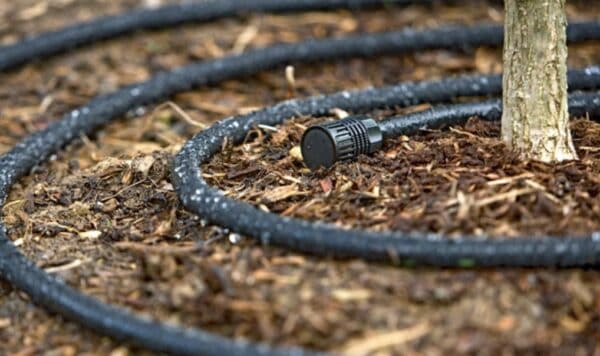How to Test if Your Trees Need Water

In the midwest the weather can be unpredictable (to say the least). Sometimes it tornados in December. One day it might be 70 degrees, the next day could be 30 degrees. Sometimes it rains… a lot. Sometimes it doesn’t rain at all. During those not so lovely midwest dry spells you want to check your trees, shrubs and other plants to be sure they are properly hydrated. Here are some tips on how to properly check for hydration and how to tell is your trees and plants are being under/over watered!
Please note, if you have trees/shrubs that fall under Frisella Nursery’s plant warranty (1 year if planted by us, 6 moths if you plant yourself) the warranty could be voided if the tree/plant is not watered properly.
Customer/client responsibilities:
Once plants are planted and mulched the responsibility of watering becomes the property owners. This includes checking to see that plants are not over or under watered each season of the year including the winter season. ***This is not the case if signed up with Frisella’s after care program or an ongoing maintenance contract.
Here’s a few important notes on “hand watering” & irrigation systems…
Irrigation systems
- These are not flawless end all be all systems. Large trees will not properly be watered by normal irrigation zones in most landscapes. They WILL require supplemental watering. See watering guide and steps to setup hoses/watering bags.
- Turf zones MUST NOT spray into landscape beds. This will void your Frisella plant warranty. Turf zones put down much more water than is required for landscape plantings
Hand watering – The best way to water large trees is the following:
- Connect all your hoses required to reach the furthest tree
- Turn the hose on and allow it to run for 1 – 2 min so all the air is removed from the hose
- Turn the hose off
- Set the hose at the trunk of the tree
- Ever so slightly crack the hose back on. (This may take a little adjusting to get a consistent ‘trickle’ from the hose. PLEASE NOTE: A hose running uphill will take more pressure than one running downhill)
- Let the hose run on each tree for 8 – 12 hours. Once you have watered all of your trees once like this, you should go right back through and water them each for 8 – 12 hours again (assuming you are not using more than 2 hoses)
- After these two waterings, you should be to a point to water like this once every two weeks.
To get the clearest picture of if your plant is getting enough water you could dig down 8″ – 12″ (depending on the size of the rootball) and dig a little bit of soil out of the rootball (not the soil around it), if you can roll that soil in your fingers and as soon as it forms a ball it starts to crumble, that is perfect. If it is hard as a rock and you cannot get a sample, it’s time to start watering. If you get into the rootball and its sloppy and watery, cut the water off for a week and reassess before watering again.
The winter months are just as critical and in some cases even more so. If evergreens like the Arborvitae go into winter dry they will dry out very quickly because the dry winter winds will suck the moisture out of the plant through its foliage. We typically recommend spraying an anti-dessicant on broadleaf evergreens (Arborvitae, Boxwood, Hollies, etc…) in the early winter to help with this. Watering with the ‘trickle method’ described above can typically go to every 3 weeks when the weather is conducive to watering. This is critical because irrigation systems are shut off and there is even less water running.
The following are typical signs of plants drying out
- Dying back of branches starting at the tips and back towards the center of the plants
- Edges of leaves drying and defoliation
- Wilting
The following are typical signs of overwatering
- Yellowing leaves
- Yellowing foliage on the insides of the tree/shrubs working out to the outside
- Wilting (typically azaleas, rhododendron, and some perennials are mistaken for drying out when they are being overwatered and why checking the soil is crucial)
How do we determine whether a plant is dying because of a watering issue or not?
- Soil Ball Test: Dig into the soil on the edge of the rootball 8 – 12” down from the top of the rootball.
- If there are 3 or more #3 shrubs or larger (shrubs and trees) dying within 10-15 feet of each other and the soil fails the soil ball test, there is water that fills up a test hole, or the rootball is hard as a rock then it’s a watering issue and the warranty is void.
Frequent concerns
- Hydrangeas – their first summer, no matter when they are planted, they will tend to get yellowing leaves and not produce many strong blooms. These get called into question at the end of the first summer frequently, but always come back strong year after year giving our clients their desired look.
- Cherry Trees – If planted late in spring or in the summer, they are likely to defoliate making the plant look thin its first year. They will leaf out in full the following season.
- Boxwoods – Typically broadleaf evergreens like boxwood will get a bronze color to the foliage in the winter, this is normal. The color will come back to the plant the following season. When there is excess water in the ground, the plant may turn a deep orange before the foliage begins to die off (gold crispy leaves). This is not normal.